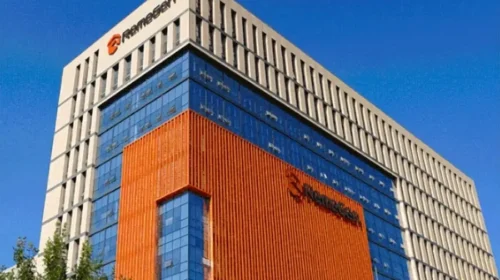Fosun’s Luxury Dream Advances as Lanvin Group Nears New York Listing

Financial conglomerate’s recently formed luxury group, whose brands include Sergio Rossi and St. John Knits, says it expects to complete a SPAC listing by year-end
Key Takeaways:
- Fosun’s Lanvin Group of luxury brands said it expects to complete a SPAC listing in New York by the end of this year
- Company reported 339 million euros in revenue last year, and aims to triple that by 2025 through acquisitions and big growth in China and North America
By Doug Young
Just days after we wrote about a company whose plan to become China’s first global luxury giant was rapidly unraveling, another Chinese company has just announced its own latest developments with the same goal in mind. But whereas the first case involved a textile giant named Ruyi Group (002193.SZ), the latest one involves financial conglomerate Fosun (0656.HK), which is preparing to list its recently formed Lanvin Group in New York.
We previously wrote about Lanvin in March when it first announced its plans to make a backdoor listing by merging with Primavera Capital Acquisition Corp. (PV.US), a special purpose acquisition company (SPAC). Lanvin has just announced some new limited financial results for 2021, and also filed a form with the U.S. securities regulator containing more details on its listing plan.
Truth be told, the financial data contained in the latest announcement is quite cherry-picked, aimed at showing the best possible face for Lanvin as it tries to sell itself to investors. We’ll need to see more complete numbers to get a better idea of the company’s prospects, which Lanvin will be required to give after the listing is complete and it becomes a regular publicly traded company.
The group was cobbled together by Fosun over the last few years through a series of acquisitions, and now includes its namesake Lanvin brand, as well as Italian luxury shoemaker Sergio Rossi; American womenswear brand St. John Knits; Austrian skinwear specialist Wolford; and Italian menswear maker Caruso.
Before we look at the newest information, we’ll start by briefly discussing the differences between Lanvin and Ruyi, which we mentioned at the outset, for a better idea of whether the former might have more success with its luxury bid than the latter. Ruyi embarked on a similar plan to Lanvin’s around a decade ago, purchasing big global brands including Lycra, SMCP, Cerruti 1881, and Gieves & Hawkes. But the company took on too much debt, and it made headlines late last month when it lost control of Lycra to some of its creditors.
By comparison, Fosun is one of China’s most successful privately owned financial conglomerates, and is far more experienced at global acquisitions and finance. The company’s other global brands include French resort operator Club Med and Portugal’s biggest bank, giving it lots of experience operating big global assets and also managing big debt loads. By comparison, Ruyi was a powerhouse in the global textile market, but had little experience at global deal-making and global M&A before its acquisition spree.
Here, however, we should also note that Fosun was in the news earlier this month when foreign media reported investors were dumping its bonds after global ratings agency Moody’s launched a review of the company related to its large debt. Most of China’s other big privately owned financial highflyers like HNA Group and Anbang Insurance embarked on similar global acquisition sprees before crashing under heavy debt loads, so it’s always possible Fosun could follow down that path.
Still, its greater experience at managing this kind of acquisition-related debt and operating international assets lead us to believe Fosun is more likely to succeed with Lanvin than Ruyi was with its global luxury aspirations.
Stay tuned
All that said, we’ll spend the second half of this space looking at the latest news on Lanvin’s listing plans and also the limited new financial data it gave for 2021. There’s not much new on timing for the listing, though Lanvin says it expects the deal to be complete by the end of this year. The latest regulatory filing says Lanvin will issue about 192 million ordinary shares, and Primavera Capital Acquisition Corp. shareholders will get 28% of those.
Primavera Capital Acquisition Corp. raised $414 million through an IPO in early 2021, and has a current market value of $529 million. The shares have been thinly traded for most of their life, and their latest closing price of $9.85 is just a tad below the sale price of $10. That appears to show investors think the stock is fairly valued at its current price, which was unchanged in Tuesday trade after release of the latest updates.
The company said it generated pro forma revenue of 339 million euros ($340 million) in 2021, which is roughly the same as the 333 million euros it forecast when it first announced the SPAC listing plan in March. The revenue was up about 26% if we include revenue for both 2020 and 2021 from the company’s Sergio Rossi brand, which Lanvin acquired in July last year. Lanvin is giving a different figure of 52% revenue growth for last year, which includes Sergio Rossi’s revenue for all of 2021 but no contribution from the Italian brand in 2020.
Either way of looking at revenue growth seems fair, since Lanvin is really just a series of different brands acquired at different times over the last few years. The company is currently losing money, and in March said it posted an adjusted EBITDA loss of about 85 million euros last year. In the latest announcement, Chairman Joann Cheng reiterated the company’s previously stated goal of reaching breakeven on an adjusted EBITDA basis in 2024.
The company has also said it plans to make at least one more major acquisition to help it reach its relatively aggressive target of reaching nearly 100 million euros in sales by 2025, which would represent a tripling from last year’s level.
Lanvin also hopes to reach those targets by building up its sales in North America and China, which collectively accounted for about half of its total last year. It noted in its latest announcement that its 2021 North America sales were up 253% from 2020, and its Greater China sales rose 134% over the same period. It’s also putting big hopes on e-commerce, and pointed out that part of the business rose 415% last year without giving any specific figures.
“We expect 2022 to be even better,” Cheng said. “We have significant momentum across all of our brands as we continue to solidify our foundation in Europe and capture the multiple untapped opportunities which exist in the North American and Asian markets.”
To subscribe to Bamboo Works free weekly newsletter, click here






